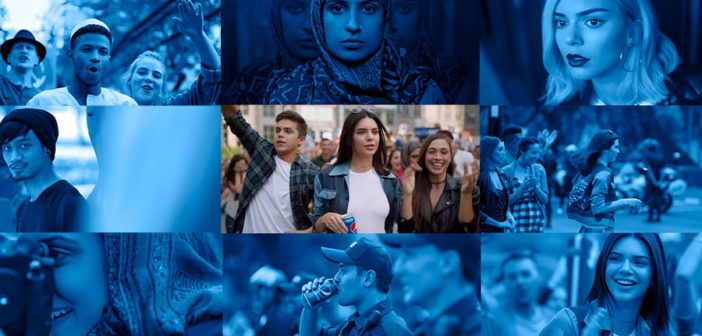Experts weigh in on the soda-maker’s tone-deaf debacle
Since the moment Pepsi released its new two-and-a-half minute spot—featuring Kendall Jenner, protesters and a message of unity via soda—response to the ad has been anything but positive.
According to data from Amobee Brand Intelligence, digital content engagement around Pepsi has increased significantly (366 percent in just a day), but 43 percent has mentioned Black Lives Matter, 31 percent has labeled the ad as “tone-deaf” and 10 percent has tagged it as the “worst ever.” Amobee also looked at content engagement around the term “tone-deaf” in the last day, and 77 percent of digital content using the term mentioned Kendall Jenner and Pepsi.
So what happened? How did Pepsi get here and what can marketers learn from this debacle?
“Pepsi should have consulted people who have actually been on the front lines of protests these recent years,” explained writer, social worker and activist Feminista Jones. “The organizers, protesters, educators … all of those who have been instrumental in bringing about these recent movements for justice. Brands should never make light of social issues related to people’s suffering; they should, instead, focus on selling their products in ways that don’t exploit the pain and suffering of marginalized people.”
Allen Adamson, long-time brand consultant and founder of Brand Simple Consulting, agreed: “It’s trivializing the seriousness of the issue, that merely a can of Pepsi could solve all of the problems on the streets of our country. To some extent, it’s polarizing to the Black Lives Matter movement because it makes it seem like much ado about nothing, if you just passed some out at your demonstrations this wouldn’t happen.”
Criticism of the ad, created by Pepsi’s in-house team, Creators League Studio, isn’t focused on just one aspect. Many take issue with the use of Jenner, with the brand casting a rich, cis, able-bodied white woman as the hero of the people, as well as the way that it portrays protest as an upbeat social outing.
The ending of the ad, with Jenner handing a Pepsi to a police officer, also evoked comparisons to historical images of protest, like Reuters’ image of activist Ieshia Evans, and many were put off by what they saw as an “exploitative brand social activism” for the sake of capitalism.
“Ridiculous ad,” said Edward Boches, professor of advertising at Boston University and a former partner, CCO at Mullen Lowe. “Shows no awareness of the protesters’ mindset or environment. Feels completely dishonest and contrived. Was clearly done by people who have not attended a protest or spent time on the streets and have no understanding of the pent-up anger.”
For some, the work was also reflective of larger issues in the advertising business. “This is what happens when you don’t have enough people in leadership that reflect the cultures that you represent,” wrote Eric Thomas, senior partner and brand specialist at Saga MKTG, in a LinkedIn post titled, “How to Make Millennials Hate You, The Pepsi Way.”
Thomas continued: “Somewhere in the upper levels where this commercial was approved, one of two things happened. Either there was not enough diversity—race, gender, lifestyle, age or otherwise—or worse, there was a culture that made people uncomfortable to express how offensive this video is. Unfortunately for Pepsi, millennials have hyper-advanced B.S. detectors and they went off very quickly. Twitter has been merciless.”
Given Pepsi’s message of unity many have pointed to Coca-Cola’s famous “Hilltop” ad. But what did Coke get right in 1971 that Pepsi didn’t in 2017?
“The ‘Hilltop’ spot wasn’t attempting to dramatize a real event,” explained Boches. “It was clearly contrived and invented as a moment. The Pepsi spot is attempting to recreate a protest march and in a very unrealistic way. Two, the promise of the Coke spot was a simple sentiment and a wish. ‘We would like to teach … as in ‘like to.’ It was a wish.”
Boches explained why viewers reacted with a sense of anger as they sniffed out Pepsi’s inauthenticity: “The Pepsi commercial goes too far beyond that, suggesting Pepsi actually has such power. Seriously? Coke conveys a sentiment and a belief while Pepsi makes a false declaration. Coke says, ‘Wouldn’t it be nice?’ Pepsi says, ‘Look what we can do.’ So we agree with the Coke sentiment. Yes, it would be nice.”
The hopeful message of “Hilltop” isn’t the only difference though. While the Coke ad ran during a time when people called for peace and love, Boches said, “These are different times. The divisiveness is real. And sharp edged. Pepsi is dismissing the seriousness of that divide by implying that a celebrity (not a very genuinely active one either) can bridge that divide with a Pepsi? Please. Pepsi should apologize and move on.”
–
Photo Illustration: Dianna McDougall; Source: YouTube
This article first appeared in www.adweek.com
Seeking to build and grow your brand using the force of consumer insight, strategic foresight, creative disruption and technology prowess? Talk to us at +9714 3867728 or mail: info@groupisd.com or visit www.groupisd.com

